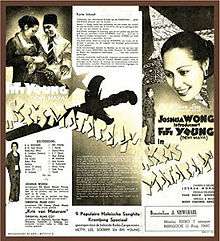Kris Mataram
Kris Mataram is a 1940 film from the Dutch East Indies that was directed by Njoo Cheong Seng and starred Fifi Young and Omar Rodriga as two lovers divided by class. Young's feature film debut,[1] the film was the first produced by Oriental Film and depended on Young's stardom as a stage actress to attract viewers. It may be a lost film.
| Kris Mataram | |
|---|---|
 Theatrical poster | |
| Directed by | Njoo Cheong Seng |
| Starring |
|
| Cinematography | Joshua Wong |
Production company | |
Release date |
|
| Country | Dutch East Indies |
| Language | Malay |
Plot
A young noblewoman from Kartasura, R. A. Roosmini (Fifi Young), falls in love with a commoner named Bachtiar (Omar Rodriga). She wants to be with him, but her father R. M. Hadikusumo insists that she marry a man from a similar background. The two run away together, but Bachtiar is recalled by his family and forced to marry a woman he does not love. Roosmini, rather than marry a man she does not love or live alone, stabs herself with her sacred kris and dies.[2][3]
Production
Kris Mataram was produced by Oriental Film, a newly established studio.[4] It brought Fifi Young and her husband Njoo Cheong Seng to the studio: Young – a former stage star – to act and Njoo to direct and write the film. It was his directorial debut,[5] and the script for Kris Mataram had previously been intended for the stage.[1] Joshua Wong, formerly of Tan's Film, was drawn to Oriental Film to handle the cinematography for Kris Mataram. Wong was disappointed over the profit sharing of his ventures with Tan's.[6]
The title, which literally translates as "kris of Mataram", was chosen to attract attention; the Indonesian film historian Misbach Yusa Biran describes the work as not relating to the culture of Mataram.[7] The film was seen as contrasting traditionalism against modernity, as well as Western and Eastern cultures.[2] The film was black-and-white, with Malay-language dialogue.[3]
Release
The film made its debut on 29 June 1940 in Rex Theatre, Batavia (modern-day Jakarta).[5] Kris Mataram was targeted at lower-class audiences.[8] Biran writes that its audiences were mostly those who enjoyed the traditional toneel stage plays, partly because of the film's reliance on Young to attract viewers.[9]
Kris Mataram is likely a lost film. The American visual anthropologist Karl G. Heider writes that all Indonesian films from before 1950 are lost.[10] However, JB Kristanto's Katalog Film Indonesia (Indonesian Film Catalogue) records several as having survived at Sinematek Indonesia's archives, and Biran writes that several Japanese propaganda films have survived at the Netherlands Government Information Service.[11]
References
Footnotes
- Setiono 2008, p. 398.
- Biran 2009, pp. 252–253.
- Filmindonesia.or.id, Kris Mataram.
- Biran 2009, p. 204.
- Biran 2009, p. 228.
- Biran 2009, pp. 220, 223.
- Biran 2009, p. 256.
- Biran 2009, p. 248.
- Biran 2009, p. 250.
- Heider 1991, p. 14.
- Biran 2009, p. 351.
Bibliography
- Biran, Misbach Yusa (2009). Sejarah Film 1900–1950: Bikin Film di Jawa [History of Film 1900–1950: Making Films in Java] (in Indonesian). Komunitas Bamboo working with the Jakarta Art Council. ISBN 978-979-3731-58-2.CS1 maint: ref=harv (link)
- "Kris Mataram". filmindonesia.or.id (in Indonesian). Jakarta: Konfidan Foundation. Archived from the original on 25 July 2012. Retrieved 25 July 2012.
- Heider, Karl G (1991). Indonesian Cinema: National Culture on Screen. Honolulu: University of Hawaii Press. ISBN 978-0-8248-1367-3.CS1 maint: ref=harv (link)
- Setiono, Benny G. (2008). Tionghoa dalam Pusaran Politik [Indonesia's Chinese Community under Political Turmoil] (in Indonesian). Jakarta: TransMedia Pustaka. ISBN 978-979-96887-4-3.CS1 maint: ref=harv (link)
External links
- Kris Mataram on IMDb